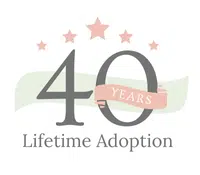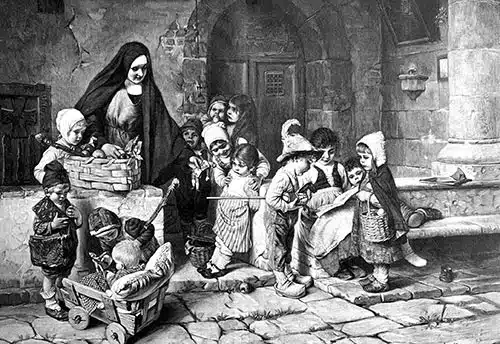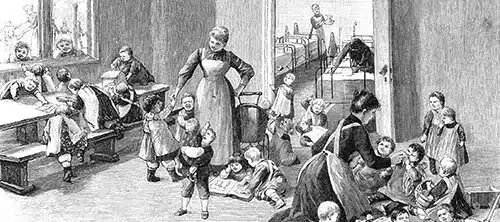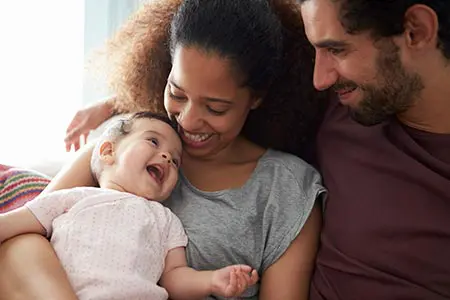Do Orphanages Still Exist in America?
When people think about orphanages in the US, they think of everything from Annie to the closing song in Broadway’s Hamilton. Furthermore, ideas about orphanages, both positive and negative, have taken root in American popular culture. People often wonder, ‘do orphanages still exist in America’? In researching about adoption, you may wonder how modern adoption compares to these images of early American orphanages. Does orphan adoption still exist in the US?
An Overview of Orphanages to Adoption
The path from the first American orphanages to modern adoption is a complicated journey that reflects our society’s changing values about child welfare. No, American children are no longer placed in orphanages because these institutionalized settings proved to be harmful to children’s development and well-being. Advocates worked to change the laws, policies, and language we use in reference to children and adoption.
As American society learned to prioritize the mental and physical health of its children, orphanages and institutions transformed into the current foster care system and today’s best practices in modern open adoption.
Images of orphanages from stories and movies have created some common misconceptions about adoption however, the true history of the American orphanage is complex. Welfare for children evolved as America developed into a more established country and now there is a clear difference between the “orphan” adoption story of the past and the loving choice in today’s modern adoption.
The First American Orphanages
America’s first orphanage was created in 1729. After White settlers in Natchez, Mississippi were killed in a conflict with Native Americans, Ursuline nuns founded the orphanage to care for the parentless children in the community. However, this wasn’t the norm. Most orphaned children in the 18th century were placed with family or other members of the community. and this was done without any of the laws or regulations that we see in the adoption process today.
A Growing Need for Orphanages and the Start of Orphan Adoption
Population in America increased due to industrialization in the 1800’s, and so did the need for orphanages. Crowded cities with insufficient sanitation created health epidemics like cholera, tuberculosis and influenza and these diseases orphaned many children, especially the children of immigrants.
Not all children living in orphanages in the US were actually orphans. Some families struggling with poverty, addiction or the loss of one parent could no longer afford to care for their children and as a result, orphanages provided the families with some financial relief. These placements were sometimes temporary, and the children returned to their families when circumstances improved.
With provisional support, families had an opportunity to get back on their feet and stay intact. Obviously, this scenario hints at our modern foster care and welfare systems.
How the Civil War Changed Things
The Civil War and another wave of immigration dramatically increased the number of orphans in America. As a result, orphanages became overcrowded and many lacked the funds to properly feed, clothe, and care for children. Limited resources and the absence of government regulation led to many problems with the orphanage system.
Private and charitable organizations that funded many orphanages in the 1800’s often had their own agenda. They saw orphanages as a way to address America’s social problems. By teaching the children how to become proper citizens and to value hard work, they believed they could keep them from living an “unsavory” life. These practices were often abusive and surprisingly the children were sometimes used for labor, and children of immigrants were forced to reject their culture.
Orphan Trains
In the mid-1800’s, a Congregationalist minister named Charles Brace devised a solution for the overcrowded orphanages in large cities and led the way in orphan adoption. He believed that orphans would have a better life if they lived with families rather than in institutions. While that line of thinking does reflect what we now know about child development, he missed the mark when he developed the Orphan Train program.
During the program’s existence, over 200,000 parentless children from eastern cities were placed on “orphan trains” and taken out west. When they arrived at destinations such as Nebraska or Texas, adoptive families were waiting to make their selection, sometimes right from the platform. If a child wasn’t selected, he reboarded the train and repeated the process at the next stop.
There was little, if any, vetting process for these adoptive families and as a result, many children entered abusive situations, and they were expected to work in exchange for their new home. Some were given away to other families or sent back to the trains if they didn’t meet their new family’s expectations. Orphan adoption or The Orphan Train program addressed the problem of overcrowded orphanages by providing cheap labor to midwestern farmers. While some children were placed with loving families who provided a better life, the overall program was based on the needs and interests of adults.
This stands in stark contrast to modern adoption practices where everyone works to protect the best interest of the child.
Improvements in Child Welfare
In the 1900’s, Progressive Movement leaders like Theodore Roosevelt started to think differently about solving America’s social problems. Instead of removing children from struggling families, they developed policies to help support families and keep them intact. This grew into the Social Security Act of 1935 and our modern welfare system.
Politicians also started developing child welfare policies. By the middle of the 20th century, most states passed laws that worked to protect the children being placed for adoption. These laws required prospective adoptive parents to pass a screening process and regulated how children could cross state lines. The Orphan Train program ended, and orphanages were dismantled as child advocates realized the harm caused by placing children in institutions.
American orphanages and orphan adoption of the past have been replaced by the current foster care system and domestic or international adoption agencies that lawfully place children with loving adoptive parents.
Improvements in Transracial Adoption
Today, there are many hopeful adoptive families who are open to adopting a child from another culture. This is done with love and respect for the child’s birth history.
American orphanages of the past believed that part of their mission was to “Americanize” the orphans in their care. Children of color and Native American children were especially harmed. Many of these children were removed from their homes because they were living in poverty or in conditions that did not meet White standards. Rather than provide interventions that could help support the families, social workers placed the children with White families to help them assimilate. The children were forced to abandon their birth language and culture, and replace them with “civilized” American customs. This practice was destructive to the children and their communities.
Modern adoption agencies are inclusive. They work with families of all ethnicities, cultures, and religions. Transracial adoptive families are encouraged to honor their child’s cultural heritage and teach their child to develop a positive self-identity.
Modern Adoption: Do orphanages still exist in America?
Hopeful adoptive families now go through a very different process to adopt a child. The three most common methods to grow a family through adoption are domestic adoption, international adoption, and adoption through the foster care system. Additionally, there are strict laws and regulations for each method in order to protect the child and ensure the adoption is conducted responsibly.
To answer the question ‘do orphanages still exist’, it’s important to remember that many other countries still have orphanages, so if you pursue an international adoption, you may end up working with an orphanage to adopt your child. Just like American orphanages in the past, not all children in orphanages are actually orphans. Some children are placed temporarily, so it’s important to work with a reputable organization to make sure everything is handled legally and ethically.
If you choose open domestic adoption, you will not adopt your child from an orphanage. Instead, you will work with an adoption agency that will help you through the process. In addition, you will undergo background checks and a home study to make sure you are prepared to welcome a child into your home. Finally, you will create an adoptive family profile so prospective birth parents can get to know you. The adoption coordinator you work with will help you make a match based on your preferences and the preferences of the birth parents.
Creating Your Open Adoption Plan With Lifetime Adoption
An open adoption plan allows you to maintain some level of contact with the birth parents after the child is born. The opportunity for open communication and a continued relationship is very different than adopting from an orphanage. Instead of erasing birth history and culture, adoptive parents have open, honest conversations about adoption from day one. There are no longer secrets or shameful stigmas about being adopted. Children grow up knowing they have both an adoptive family and a birth family who love them.
Adoption has evolved into a child-centered system that prioritizes the child’s physical, social, and emotional needs. Early American orphanages helped children survive by meeting their basic needs. Do orphanages still exist? Not in the US. Now, adopted children can thrive with the care and support of a loving family.
If you are interested in learning more or you are ready to grow you family through adoption, please call or text our caring coordinators at 1-727-493-0933.
Get More Info Now
If you live outside of the United States, please click here.

Lifetime Adoption, Inc. is a Licensed Child Placing Agency in Arkansas. (License AR #00050809)
Copyright © | Lifetime Adoption








